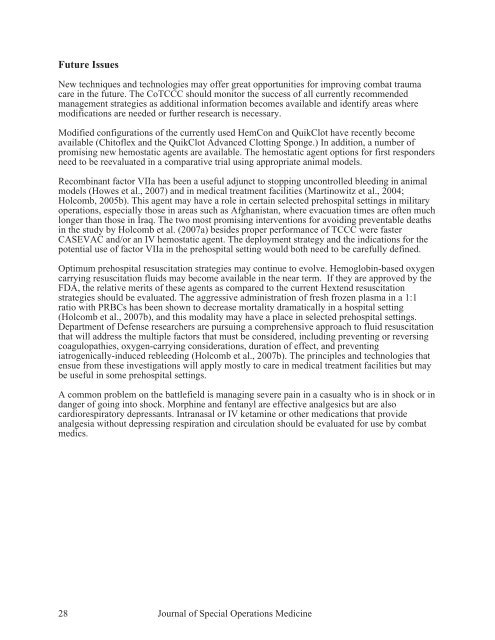Training Supplement - United States Special Operations Command
Training Supplement - United States Special Operations Command
Training Supplement - United States Special Operations Command
Create successful ePaper yourself
Turn your PDF publications into a flip-book with our unique Google optimized e-Paper software.
Future Issues<br />
New techniques and technologies may offer great opportunities for improving combat trauma<br />
care in the future. The CoTCCC should monitor the success of all currently recommended<br />
management strategies as additional information becomes available and identify areas where<br />
modifications are needed or further research is necessary.<br />
Modified configurations of the currently used HemCon and QuikClot have recently become<br />
available (Chitoflex and the QuikClot Advanced Clotting Sponge.) In addition, a number of<br />
promising new hemostatic agents are available. The hemostatic agent options for first responders<br />
need to be reevaluated in a comparative trial using appropriate animal models.<br />
Recombinant factor VIIa has been a useful adjunct to stopping uncontrolled bleeding in animal<br />
models (Howes et al., 2007) and in medical treatment facilities (Martinowitz et al., 2004;<br />
Holcomb, 2005b). This agent may have a role in certain selected prehospital settings in military<br />
operations, especially those in areas such as Afghanistan, where evacuation times are often much<br />
longer than those in Iraq. The two most promising interventions for avoiding preventable deaths<br />
in the study by Holcomb et al. (2007a) besides proper performance of TCCC were faster<br />
CASEVAC and/or an IV hemostatic agent. The deployment strategy and the indications for the<br />
potential use of factor VIIa in the prehospital setting would both need to be carefully defined.<br />
Optimum prehospital resuscitation strategies may continue to evolve. Hemoglobin-based oxygen<br />
carrying resuscitation fluids may become available in the near term. If they are approved by the<br />
FDA, the relative merits of these agents as compared to the current Hextend resuscitation<br />
strategies should be evaluated. The aggressive administration of fresh frozen plasma in a 1:1<br />
ratio with PRBCs has been shown to decrease mortality dramatically in a hospital setting<br />
(Holcomb et al., 2007b), and this modality may have a place in selected prehospital settings.<br />
Department of Defense researchers are pursuing a comprehensive approach to fluid resuscitation<br />
that will address the multiple factors that must be considered, including preventing or reversing<br />
coagulopathies, oxygen-carrying considerations, duration of effect, and preventing<br />
iatrogenically-induced rebleeding (Holcomb et al., 2007b). The principles and technologies that<br />
ensue from these investigations will apply mostly to care in medical treatment facilities but may<br />
be useful in some prehospital settings.<br />
A common problem on the battlefield is managing severe pain in a casualty who is in shock or in<br />
danger of going into shock. Morphine and fentanyl are effective analgesics but are also<br />
cardiorespiratory depressants. Intranasal or IV ketamine or other medications that provide<br />
analgesia without depressing respiration and circulation should be evaluated for use by combat<br />
medics.<br />
28 Journal of <strong>Special</strong> <strong>Operations</strong> Medicine

















